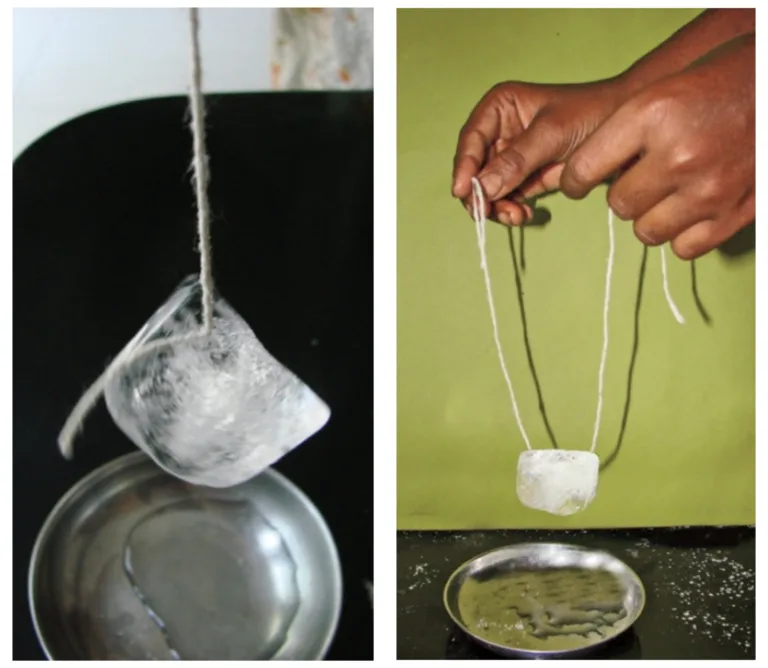Lesson 4 – Your Own Book of Science
I
A Simple Experiment:
Lifting lce!
If you wanted to lift ice without touching it, what do you do? Read on to find out.
What you need:
Ice cubes, thread, common salt.
What you do:
- Place an ice cube in a dish.
- Place a piece of thread on it.
- Sprinkle some common salt on and near the thread on the ice cube.
- Wait for a few seconds.
- Hold the two ends of the thread and pick them up carefully.
What happens?
Ans: When you sprinkle salt on the ice cube with a thread on it, the ice around the thread melts a little. Then, the melted ice mixes with the salt, creating a watery solution. This solution has a lower freezing point than normal ice. As a result, the thread gets stuck in the melted part of the ice cube. When you pick up the thread, the ice refreezes, holding the thread in place.
Try placing the thread in different ways to lift the ice. You can place just one end of the thread on the ice cube and lift the ice with the other end!

II
Puzzles in your Surroundings
Note down at least ten such questions on the basis of your observation of things and events in your surroundings.
A few examples are given below.
- Where do flowers get their colour from?
- Why are leaves green ?
- Why does chopping an onion make you cry?
Note each question on a separate page in your “Book of Science’. Draw suitable pictures or paste related photographs on that page.
Try to find the answers to your questions with the help of your parents, teachers or friends. Make use of science journals and reference books to find the answers. You may find the answers on the internet. With the permission and guidance of your parents/ guardians or teachers, browse through the informative websites.
You may find some of the answers you need in your textbooks or in other informative books. Note down the answers on the relevant pages.
When you have collected a few experiments and answers to your questions, put them all together in your very own Book of Science”.
The questions are:
1. Why is the sky blue?
Ans: The sky is blue because sunlight spreads in the air, and blue light scatters more.
2. How do birds know how to build nests?
Ans: Birds learn to build nests from their parents or instinct.
3. Why do we have different seasons?
Ans: Earth tilts, giving us different weather in different times called seasons.
4. What makes the wind blow?
Ans: Wind happens when the air moves around from high to low pressure.
5. How do plants grow from tiny seeds?
Ans: Plants grow from seeds with water, sunlight, and soil nutrients.
6. Why does ice cream melt on a hot day?
Ans: Heat from the sun makes ice cream melt on hot days.
7. Why do stars twinkle at night?
Ans: Air makes starlight twinkle as it comes through Earth’s atmosphere.
8. How do bees make honey?
Ans: Bees collect sweet nectar from flowers and turn it into honey.
9. What causes thunder and lightning during a storm?
Ans: Storms create loud thunder and bright lightning due to clouds colliding.
10. Why do some animals hibernate in the winter?
Ans: Animals hibernate to sleep and save energy during cold winters.
